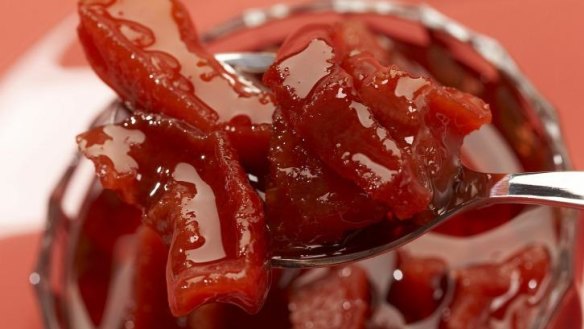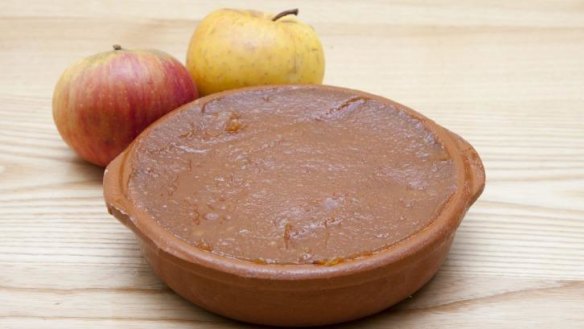Best quinces for jam, sauce recipes in Canberra district

The twisted and knobbly quince trees have produced a veritable golden harvest this year. There are few better sights than a quince tree loaded down with these amazing large fruits in mid autumn. It seems that the long hot days of late summer have been just fine for this fruit, whereas some other fruits have struggled with the long dry periods.
A very unusual fruit indeed: inedible when raw but deliciously soft and aromatic when cooked. For those folk who have come from Greece, Turkey, Persia and Turkestan to Australia, they can enjoy the harvest of a tree that has been growing in those parts of southern Europe and Asia for thousands of years. The Roman Empirical leaders sought to grow and have ready access to this favoured crop. They were then extensively grown in France by Charlemagne's time in the 9th century.
The inland tablelands regions of Australia do suit the growing of quinces. Cold winters and quite hot summers and still warm autumns, with lots of sunshine, will produce a wonderful crop come the month of April.

The fruit takes some seven months to mature, after emerging from the delicate pinky white flowers that adorn the trees in late September. If you have sufficient space for a 3-4 metre high, spreading tree, then a quince tree is a good ornamental choice. However, it is the fruit that is the best element.
Quinces have a high pectin content so you can easily make the delightful quince jelly or quince jam without adding any additional pectin. When making quince jam, save the peeled skins and cores of the quinces and place them in a muslin bag into the pot with the fruit, while cooking, to provide additional pectin.
I planted several quinces in an area when early cherry tree plantings all died off, from a very wet winter. The quince is one of the hardiest fruit trees, surviving and prospering in quite heavy soils. Many nurseries actually use quince rootstock as the base when grafting pear varieties.
If you were to walk along the rows of apple trees in our orchard, you might be surprised to see the occasional quince tree. In fact, we have planted a "replacement" quince tree whenever an apple tree had fallen prey to overly wet conditions, with poor drainage.
The fine dining restaurants of Canberra give priority to sourcing local quinces for their mains and dessert menus in April and May. Ben Willis of Aubergine has been preparing creative dishes with Loriendale quinces over the past five years and diners can expect special seasonal dishes again this year
Smyrna quinces are the old favourite for many people in Australia, originating in the islands of Greece. It was the variety growing in our family farm at Canowindra in the 1960s, as was case for many rural folk. Smyrna matures quite early and has a light lemon, yellow appearance. It can be quite large in size and is often very knobbly. For such quinces, use a knife with a cutting board, always pointing the blade downwards and away from yourself.
In recent years, we have had specialist propagation nurseries source other high quality varieties. De Vranja is another early maturing. large pear shaped quince which originated in Croatia. When poached in a small amount of water, the flesh of this quince will turn into a light pink colour.
I have also planted some Angers quinces, named after the city in the Loire Valley of France where many fruits are grown with excellent results. We have hosted agricultural students on internships from the Angers Institute. Angers quinces are relatively small. So too is the tree itself, so it could be planted in a small garden. It is a heavy cropper and cooks to a beautiful deeper colour.
De Bourgueaut is another quince originating from France. It has amazingly large leaves and the juicy flesh of this variety has a mild taste which, when cooked, takes on a beautiful deep hue.
There are several varieties which are more rounded and smoother in appearance. Champion comes from America, ripening in mid season and has good flavour when cooked. Fullers quince is another American variety, dating back to the 1860s, yielding distinctive, large fruit that are very aromatic.
Pineapple quince was bred in California more than 100 years ago and its pear-shaped fruit has a slight pineapple flavour. It is one of the best late season quinces and can be used to make top quality quince jelly and quince jam. It is also a fine variety to use for baked quinces.
Making quince jelly is a time-consuming project but the end result is worth the effort. You first need to cut up the unpeeled fruit into small segments. Place in a large stainless steel cooking pot and just cover with water. Bring to the boil and cook until the fruit softens then strain through a cotton or muslin bag. Weigh up the liquid and measure out the same weight of sugar. Warm the sugar and add to the liquid. Bring to the boil and then simmer until it begins to thicken. When the jelly has thickened sufficiently, bottle in sterilised jars and seal well.
Quince and apple sauce
2 large quinces
3 cooking apples
½ cup raw sugar
peel of one lemon
4 whole cloves
1½ cups water
Peel and core the quinces and apples. Dice the fruit and place in a stainless steel, heavy duty saucepan. Add in the sugar, lemon peel and whole cloves. Just cover with water and place on medium heat. Bring the pan to boiling and then gently simmer until the fruit is soft. Remove the lemon peel and the cloves. Mash the soft fruit until very smooth. A wonderful accompaniment with roast pork, lamb or lamb shanks.
This week in the garden
* Begin the planting of onion seeds into propagation trays, to have a good supply of seedlings for transplanting in May and June.
* Sow an autumn crop of broad beans and field peas to renew garden beds that have been growing feed heavy crops. There is still time to plant out lettuce seedlings and plant out a row of beetroot, radishes and kale.
* Remove tomato plants with green tomatoes still hanging on the branches and hang them inside a sheltered spot to keep ripening, when the frosty nights arrive.
* Keep working on preparing a garden bed for planting out garlic and seek out Australian grown garlic for planting. Ingelara produces excellent local garlic and sells each Saturday at the Capital Region Farmers Market.
* When picking and storing pears, check that they are unblemished. Poach or dry those with any damage.
Owen Pidgeon runs the Loriendale Organic Orchard near Hall.
Restaurant reviews, news and the hottest openings served to your inbox.
Sign up